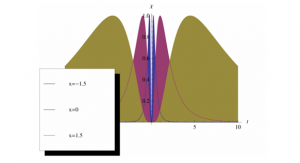
As reported in MIT’s Technology Review …
Entanglement is the strange quantum phenomenon in which two or more particles become so deeply linked that they share the same existence.
That leads to some counterintuitive effects, in particular, when two entangled particles become widely separated. When that happens, a measurement on one immediately influences the other, regardless of the distance between them. This “spooky-action-at-a-distance” has profound implications about the nature of reality but a clear understanding of it still eludes physicists.
Today, they have something else to puzzle over. Jay Olson and Timothy Ralph at the University of Queensland in Australia say they’ve discovered a new type of entanglement that extends, not through space, but through time.
They begin by thinking about a simplified universe consisting of one dimension of space and one of time.
It’s easy to plot this universe on a plane with the x-axis corresponding to a spatial dimension and the y-axis corresponding to time.
If you imagine the present as the origin of this graph, then the future (ie the space you can reach at subluminal speeds) forms a wedge that is symmetric about the y-axis. Your past (ie the space you could have arrived from at subluminal speeds) is a mirror image of this wedge reflected in the x-axis.
When two particles are present, both sitting on the x-axis, their wedges will overlap in the future and in the past. This has a simple meaning: these particles could have interacted in the past and could do so again in the future, but only in the areas of overlap.
Conventional entanglement cuts across this world, quite literally. It acts along the the x-axis, linking particles instantly in time and in defiance of the boundaries to these wedges.
What Olson and Ralph show is that entanglement can just as easily work along the y-axis too. In other words, entanglement is so deeply enmeshed in the universe that a measurement in the past has an automatic influence on the future.
That may sound like a truism. Isn’t this is how the universe works, I hear you say. But this isn’t ordinary cause and effect; there are some interesting subtleties to this phenomenon.
To see how, imagine an experiment that Ralph and Olson describe in which a qubit is sent into the future. The idea is that a detector acts on a qubit and then generates a classical message describing how this particle can be detected. Then, at some point in the future, another detector at the same position in space, receives this message and carries out the required measurement, thereby reconstructing the qubit.
But there’s a twist. Olson and Ralph show that the detection of the qubit in the future must be symmetric in time with its creation in the past. “If the past detector was active at a quarter to 12:00, then the future detector must wait to become active at precisely a quarter past 12:00 in order to achieve entanglement,” they say. For that reason, they call this process “teleportation in time”.
But how is this different from ordinary existence? After all, we’re all time travellers, moving into the future at the same rate. What’s special about Olson and Ralph’s route?
The answer is that Olson and Ralph’s teleportation provides a shortcut into the future. What they’re saying is that it’s possible to travel into the future without being present during the time in between.
That’s a fascinating scenario that immediately raises many questions. One of the first that springs to mind is what advantage might we get from this process. Might it be possible, for example, to make short-lived particles live longer by teleporting them into the future?
That isn’t clear. Neither is it clear exactly how such an experiment might be done although. Presumably, it wouldn’t be very different to the type of teleportation that is done in labs all over the world today, as a matter of routine (in fact Olson and Ralph say that timelike entangelment is interchangeable with the spacelike version).
That means it’s only a matter of time before somebody tries it. We’ll be watching!
To use 12 noon as the axis of reflective symmetry seems completely arbitrary. must be some missing information here…